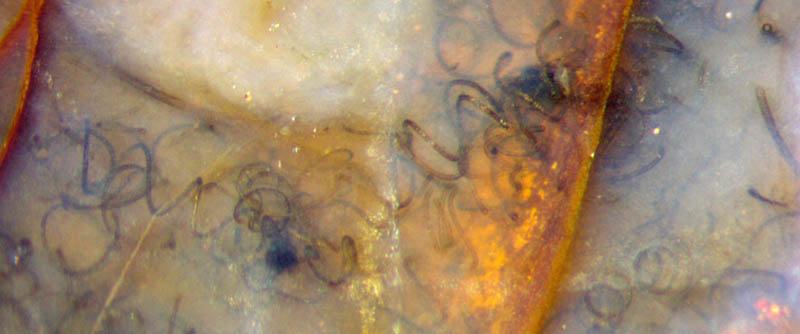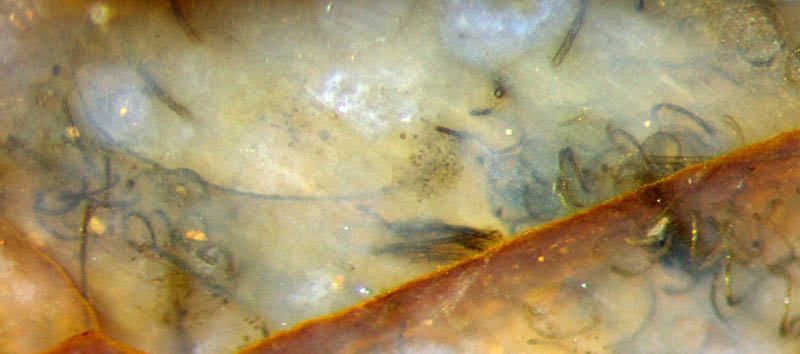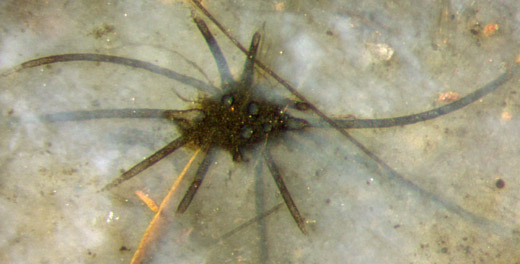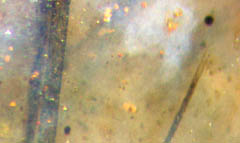Nematoplexus
- more details, more questions (1)
Nematoplexus
is one of
the rarest and least understood objects in the Rhynie chert. It belongs
to the obscure nematophytes,
which go under the heading "Enigmatic
Organisms" in [1], and is distinguished by tubes with a spiral or
screw-like
shape *. The number of samples with Nematoplexus
found hitherto is very small. The type specimen discovered and
described by A.G. Lyon [2] is probably the one which is seen on the
website of Aberdeen University [3]. The characteristic features of Nematoplexus from
that sample have first been stated in Rhynie Chert
News 29.
So it has come as a surprise that an own specimen, found in 2003,
deviates in one of
those features and shows a new one: Tube and thread diameters are
distinctly larger, and weakly curved tubes seem to be somehow
associated with the screw-like ones. This has also been observed with
another sample, found in 2014 and described here.
* Contrary to a statement in [3], Nematoplexus
is the only nematophyte with "spirally coiled" tubes.

Fig.1,2: Nematoplexus
tubes, spiralling or slightly curved, on the raw surface of a Rhynie
chert sample. Width of the
images 2mm.
Obviously the diameters of the wound tubes (10...13Ám) and threads
(0.1...0.2mm)
are
larger than those of the type specimen [2].
Other features are the same, as right-handedness of the thread and
pitch
equalling diameter, unless the tubes had undergone later deformation.
 The
enigmatic "branch knots", also known from other nematophytes, are dimly
seen as two dark spots in the depth in
Fig.1.
The
enigmatic "branch knots", also known from other nematophytes, are dimly
seen as two dark spots in the depth in
Fig.1.
In
addition to the screw-like tubes, slightly curved ones are seen in
Fig.2 as about 10 cut-off ends and one longer part. If the latter were
part of a circle, its diameter would
exceed 1mm, which is 5 to 10 times the diameter of the screws.
The
slightly curved tubes are seen scattered among the screws or well
away from them but not very far. Hitherto they have never been found in
a sample without spiralling tubes.  Hence
one may well assume that they
belong together in some way although one does not know in which way.
Hence
one may well assume that they
belong together in some way although one does not know in which way.
Any doubt concerning the nematophyte nature of
the big tubes
is dispelled by the surprise discovery of their impressive "branch
knots". Several have been seen on this sample but only one is
clearly seen on a cut plane (Fig.3).
Fig.3 (right): "Branch knot" of big slightly curved Nematoplexus tubes,
apparently the first such one ever seen. Width
of the image 1.3mm, same scale as
Figs.1,2.
Here, 4 of the tubes
(19...22Ám) are cut off at their broadened
base where they are seen as circular cross-sections of 30Ám. As an
estimate, about 20 big tubes come out of the knot. Note
also the few very thin filaments (4-5Ám)
emerging from the knot, and an
unrelated thin
tube (9Ám) passing by.

Fig.4: Nematoplexus
tubes, nearly straight, two parallel big ones on the left,
one of them 40Ám, thin one 11Ám. Same scale as
above.
Occasionally two nearly straight tubes run parallel to each
other
for some distance, apparently without spacing as in Fig.4, or several
ones make a loose bundle, as indistinctly seen in the middle of Fig.2.
(See also Rhynie Chert
News 51
, Fig.2.)
The 9Ám-tube in Fig.3 above can be followed in the depth over a
distance of 2.5mm whereby it appears that this tube is neither part of
a circle nor of a big screw similar to the small screws. Hence one may
guess that more of the weakly curved tubes are
of this type.
Fragments of tubes with spiral or
annular wall reinforcements, similar to those in
the type
specimen [2], have been found in this sample, too.
As long as Nematoplexus
rhyniensis
was known from the one fragmentary type specimen only, one could expect
that the open questions would be answered by means of more finds. This
expectation has not yet been fulfilled because Nematoplexus
has remained very rare since its first description in
1961, and if present in a chert sample, the small patches with the tiny
spiralling tubes are hard to find. The own finds have posed new
questions
without answering the
old ones.
The present sample reveals a confusing variety of tubes,
covering a wider range of size data than the
type specimen [2]
does. (There are erroneous size data in [1].) One would be tempted to
assign them to different species if there were not the intriguing fact
that they are found
concentrated within regions of a few millimeters
across. It is hoped that a consistent view will
finally arise from combining the apparently
incompatible observations.
H.-J. Weiss 2015, 2016, 2017, 2020
[1] T.N. Taylor,
E.L. Taylor, M. Krings: Paleobotany,
Elsevier 2009.
[2]
A.G. Lyon:
On the
fragmentary remains of an organism referable to the nematophytales,
from the Rhynie
chert, Nematoplexus
rhyniensis.
Trans.
Roy. Soc. Edinburgh 65(1961-62), 79-87, 2 plates.
(Scale error on Plate I Fig.1: not x19 but x1.8)
[3]
www.abdn.ac.uk/rhynie/nemato.htm
 |
 |
71 |



 The
enigmatic "branch knots", also known from other nematophytes, are dimly
seen as two dark spots in the depth in
Fig.1.
The
enigmatic "branch knots", also known from other nematophytes, are dimly
seen as two dark spots in the depth in
Fig.1.  Hence
one may well assume that they
belong together in some way although one does not know in which way.
Hence
one may well assume that they
belong together in some way although one does not know in which way.


